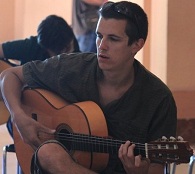Welcome to one of the most active flamenco sites on the Internet. Guests can read most posts but if you want to participate click here to register.
This site is dedicated to the memory of Paco de Lucía, Ron Mitchell, Guy Williams, Linda Elvira, Philip John Lee, Craig Eros, Ben Woods, David Serva and Tom Blackshear who went ahead of us.
We receive 12,200 visitors a month from 200 countries and 1.7 million page impressions a year. To advertise on this site please contact us.
|

|
|
Solo Compas Albums
|
You are logged in as Guest
|
|
Users viewing this topic: none
|
|
Login  | |
|

   
Ricardo
Posts: 14806
Joined: Dec. 14 2004
From: Washington DC

|
 RE: Solo Compas Albums (in reply to Stu) RE: Solo Compas Albums (in reply to Stu)
|
|
|
quote:
I'm not even sure how anyone can help here. Perhaps its just a matter of listening to them over and over until I can hear it.
Is that the case?
My opinion is a teacher needs to show you. YOu don't want to "guess at it". I think it is important for a beginner in flamenco to use a normal metronome first, learn how it feels to place the music you are learning (hopefully just some simple strumming patterns and easy, rhythmic falsetas) at a STEADY tempo with a simple click. Once the patterns are ingrained, THEN overlaying them to a compas loop or backing of some sort should be easy. But even for those that have good tempo, they still might not hear where the down beats are in the loop. So that is why a teacher is very important.
Most of the Alegrias compas CD's I have heard start the rhythm loops on count "one" of the compas cycle. If you want to be 100% sure, and don't want to get a teacher's help for whatever reason, just upload your playing here. Don't be shy, I mean if you want to guess where your playing fits against the loop, there would be plenty of us that can try to tell you what you are doing wrong, or where you SHOULD start, relative to the loop. But don't be shy or embarressed if you are wrong at first. 
Ricardo
|
|
|
|
REPORT THIS POST AS INAPPROPRIATE |
Date May 23 2007 17:33:23
 |
|

   
guitarbuddha
Posts: 2970
Joined: Jan. 4 2007

|
 RE: Solo Compas Albums (in reply to Stu) RE: Solo Compas Albums (in reply to Stu)
|
|
|
I am not hearing Alegrias that way too often, in fact the only time I hear that regularly is in remates. But I am pretty sure the way I hear it is working.
The main point of posting the Bach and stuff in compas against a buleria click was to point out that the pattern of background music doesnt nessacarily dictate the time signature of the melody presented. For example the Barrios piece is in 12/8, the fact that the buleria track makes me accent it differently ( especiall when i tap my foot on 1 2,4 5, 7 8, 9 10 ) doesnt invalidate this fact.
I hear the division of beats in Alegria to be coloured by the stress and strain of the harmony. This way is definately working for me. I also suspect that this way of looking at Alegrias may be useful to others. The reason that I think I find it useful is that I like to improvise new melody from scratch por Alegrias and the variety of ways that I have developed for thinking about the compas allows me to hold it together pretty well.
If I write material that has the pattern 2/4, starting on twelve then 3/4, 4/4 and then 3/4 then that is the sense of the music. I hear lots and lots of falsetas for solea and alegrias which follow this form and we have discussed this before. When there is a strong sense of twelve as a downbeat ( ie beat at which a structurally importand chord is felt to belong ) then I see this as a borrowing of buleria compas and I also see the form described at the top of this paragraph being borrowed for buleria.
I am aware that with enough polyrhythmic training it is possible to hear any rhythm any way that one chooses ( which was the main reason why I tossed off those very odd uploads, not because I thought that they would work particularly wel but because they would make me improve my subconscious counting and ability to hear polyrhythms and play in time with a contrasting backin track at speeds in excess of 220 ) .But for me considering melodic material as being in the time signature which it best fits is much simpler, and if I have the ability to do this and stay in compas then that is very useful.
But the perception of rhythm is very personal and academic discussion of it really requires that both parties mean precisely the same thing in each and every term that they use. Certainly guitar to guitar over a glass of wine it is much more desireable.
Also even when it is personal the interpretation is entirely functional. For example I made an audio recording of myself vocalising and african bell part and I conducted in the three obvious symmetrical (those which are represented in one measure ) time signatures that could fit it ( 3/4, 6/8. 12/16 ) ie I could periceve that there were three two or four beat per repetition of the rhythm. In the recording I found it pretty impossible to say with any certainty which on I had been thinking about at a particular time.
The specific orthodoxy of a particular way of looking at rhythm are not important as long as they are developed to the point that they are reliable.
What is important is that the accents are correct and that the pulse is solid and then the listener can make up their mind. Their decision will be dependant on
A. Their preconceptions about the form.
B. The best sense that they can make of the harmonic material ( evin if only harmony implied by melodic material )
C. They ability to flip between the the above at will without getting lost.
I like being able to flip as this makes me more able to generate a variety of melody whilst maintaining the simplicity of not having to deconstruct a particular motif that I am playing throug the filter a time signature which obscures its internal coherence.
However I have never never really played for dance and my analysis is based on some serious listening to basically instrumental guitar based music. I can see that if the dance offers another way to look at the material then this fourth option might be the most important at a particular time.
However the others deserve serious consideration, and I should know because that is what I have given them.
D.
|
|
|
|
REPORT THIS POST AS INAPPROPRIATE |
Date May 24 2007 21:26:01
 |
|

   
Ricardo
Posts: 14806
Joined: Dec. 14 2004
From: Washington DC

|
 RE: Solo Compas Albums (in reply to guitarbuddha) RE: Solo Compas Albums (in reply to guitarbuddha)
|
|
|
quote:
If I write material that has the pattern 2/4, starting on twelve then 3/4, 4/4 and then 3/4 then that is the sense of the music.
Perhaps you meant starting on one???? If not, then that really doesn't make sense to me. So if you DID mean start on count one, then your odd meter represents:
1,2=2/4 bar, where you accent one. 3,4,5=3/4, so count 3 as the accent. 6,7,8,9=4/4 so you have 6 as a down beat, 8 is the secondary beat. Then 10,11,12=3/4. So only 10 has the emphasis.
I see how that works at expressing the accents. But I think it is also important to not lose sight of the underyling feeling, even though the sound outside is achieved. It is important, IMO, regardless of the type of pattern or feel the Alegrias is taking on, whether you are doing escobilla, guitar solo falsetas, or accompanying cante, to understand the phrases starting on one are felt like pick up notes, not down beat notes. They lead into the count 3 accent. Often they start on the "&" of one, again show how much more important count 3 is. Sometimes in bulerias you have the same feeling starting from the 10 going to 12, sometimes like alegrias bulerias does the same 1-3. But the reference is the DOWN beat which WAS 12. Often you hear that expressed as a golpe before a falseta or a rasgueado intro, or even a llamada. Even if there is silence, you still must feel that rhyhmic point.
So I think you could just as well express starting from 12, as 3/4 for 12,1,2, although you can have a rest or golpe on the down beat, then I will accept your 4/4 for 6-9, but on 10, it should be 2/4, so you can really feel the down beat even thought it might again be just a golpe.
For me all the rhythmic feel can glue together with 3's or 2's very simply, rather than have to deal with alternating meters. For example, the guitar can do a similar remate as fandangos with the rasgueados, meaning count 9 has an emphasis because the rasgueado begins there. 10 can seem like a second beat close like in Fandango I mean. Also, the bulerias feel can overlay, obviously. To me, the way the music is tradtionally written seems to express escobilla type rhythms you would feel in Solea. To me, that rhythm is closely related to jaleo and bulerias, and when working with dancers, we in variabley end up going in that direction anyway. But to use it for all that is Solea/alegrias/bulerias??? At least mathematically the way they do, it is not right.
Anyway, I agree two people can feel it their own way and it still works out and sounds good. The thing I think is important though, most of the time, is that count 12. 
Ricardo
|
|
|
|
REPORT THIS POST AS INAPPROPRIATE |
Date May 25 2007 16:41:27
 |
|
 New Messages New Messages |
 No New Messages No New Messages |
 Hot Topic w/ New Messages Hot Topic w/ New Messages |
 Hot Topic w/o New Messages Hot Topic w/o New Messages |
 Locked w/ New Messages Locked w/ New Messages |
 Locked w/o New Messages Locked w/o New Messages |
|
 Post New Thread
Post New Thread
 Reply to Message
Reply to Message
 Post New Poll
Post New Poll
 Submit Vote
Submit Vote
 Delete My Own Post
Delete My Own Post
 Delete My Own Thread
Delete My Own Thread
 Rate Posts
Rate Posts
|
|
|
Forum Software powered by ASP Playground Advanced Edition 2.0.5
Copyright © 2000 - 2003 ASPPlayground.NET |
7.788086E-02 secs.
|


 Printable Version
Printable Version









 New Messages
New Messages No New Messages
No New Messages Hot Topic w/ New Messages
Hot Topic w/ New Messages Hot Topic w/o New Messages
Hot Topic w/o New Messages Locked w/ New Messages
Locked w/ New Messages Locked w/o New Messages
Locked w/o New Messages Post New Thread
Post New Thread